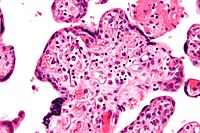
Photo from wikipedia
Aims To describe pathology found on fetal MRI and categorise into isolated or complex anomalies. Method During January 2018 data was collected from the hospital’s PACS imaging system. We performed… Click to show full abstract
Aims To describe pathology found on fetal MRI and categorise into isolated or complex anomalies. Method During January 2018 data was collected from the hospital’s PACS imaging system. We performed an advanced search using the term ‘MRI pelvis obstetric’ in the procedure description and used search dates 2008 until present. Data was collated onto an Excel spreadsheet, anonomysed and coded. Data collected included maternal date of birth, MRI study number, study date, gestation at time of study, fetal medicine consultant, whether malformation present, type of malformation (coded), follow up MRI details and whether the fetus was born. Results 108 fetal MRIs were undertaken under the two fetal medicine consultants. The years the MRIs were performed are as follows: 12 in 2017, 20 in 2016, 23 in 2015, 15 in 2014, 12 in 2013, 4 in 2012, 11 in 2011, 3 in 2010, 5 in 2009, 3 in 2008. 49 of the 108 studies had a gestation documented or was calculable from MRI request. The MRIs were all done between 18 and 37+/40 gestation. Of those 108 studies, 50 were normal and 52 had abnormalities considered outside the limits of normal variants. 3 MRIs were unable to confirm or exclude structural abnormalities. Of the isolated abnormalities the most common by far was ventriculomegaly (29 of 52 abnormal studies). 8 of the 52 abnormal fetal MRIs showed a posterior fossa abnormality, 5 had a cortical development disorder and 2 had fetal intracranial haemorrhage. 7 of the abnormal studies showed a more complex picture with at least two significantly abnormal structural malformations. Two twin studies showed abnormalities. 3 of the 52 abnormal studies had a second fetal MRI during the pregnancy. Conclusions This observational study shows that our study population of women referred for fetal MRI due to concerns on ultrasound scan or high risk of malformation (such as CMV during pregnancy) demonstrated normal fetal cerebral anatomy in 46% of the MRIs. The majority of abnormalities are isolated, most commonly ventriculomegaly. This data could be useful when obtaining consent from expectant mothers for fetal MRI.
Journal Title: Archives of Disease in Childhood
Year Published: 2019
Link to full text (if available)
Share on Social Media: Sign Up to like & get
recommendations!